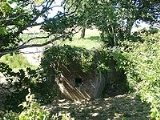
Yaverland Battery
Encyclopedia
Yaverland Battery is a battery
located in Yaverland
on the Isle of Wight
, United Kingdom
.
The battery was completed in 1863 and was one of numerous forts built along the English coastline to protect England from an anticipated French invasion, under direction of Prime Minister Lord Palmerston. Over the years the battery was subject to a number of adaptations and was still in use until the 1950s as a training centre. By 1902 the original rifle muzzle-loading weapons had been replaced by three 6-inch breech-loading Mk. VII guns, two of which were in use during the First World War. From 1906 it operated as an examination battery. In 1943 the battery was recommissioned and manned by the Home Guard for the duration of the Second World War. In 1956 it was finally sold off and the site became the location of the Sandown Bay Holiday Centre. As holiday centre grew and developed on the land, parts of the fort were flattened, with other sections left to become overgrown.
In Summer 2008, the holiday camp was acquired by new owners, who decided the remains of the fort should be preserved and recovered to form an integral part of the area.
Today, much of the surrounding Carnot wall has gone but most of the long seaward section remains, together with its two musketry Caponiers, and so gives a good view as to how it looked when it was first built. Inside, areas that were once back filled
with spoil have now been excavated bringing sections of the fort back to their original state.
Artillery battery
In military organizations, an artillery battery is a unit of guns, mortars, rockets or missiles so grouped in order to facilitate better battlefield communication and command and control, as well as to provide dispersion for its constituent gunnery crews and their systems...
located in Yaverland
Yaverland
Yaverland is a village on the Isle of Wight, just north of Sandown. It has about 200 houses. About 1/3 of a mile away from the village is the Yaverland Manor and Church. Holotype fossils have been discovered here of Yaverlandia and a pterosaur, Caulkicephalus...
on the Isle of Wight
Isle of Wight
The Isle of Wight is a county and the largest island of England, located in the English Channel, on average about 2–4 miles off the south coast of the county of Hampshire, separated from the mainland by a strait called the Solent...
, United Kingdom
United Kingdom
The United Kingdom of Great Britain and Northern IrelandIn the United Kingdom and Dependencies, other languages have been officially recognised as legitimate autochthonous languages under the European Charter for Regional or Minority Languages...
.
The battery was completed in 1863 and was one of numerous forts built along the English coastline to protect England from an anticipated French invasion, under direction of Prime Minister Lord Palmerston. Over the years the battery was subject to a number of adaptations and was still in use until the 1950s as a training centre. By 1902 the original rifle muzzle-loading weapons had been replaced by three 6-inch breech-loading Mk. VII guns, two of which were in use during the First World War. From 1906 it operated as an examination battery. In 1943 the battery was recommissioned and manned by the Home Guard for the duration of the Second World War. In 1956 it was finally sold off and the site became the location of the Sandown Bay Holiday Centre. As holiday centre grew and developed on the land, parts of the fort were flattened, with other sections left to become overgrown.
In Summer 2008, the holiday camp was acquired by new owners, who decided the remains of the fort should be preserved and recovered to form an integral part of the area.
Today, much of the surrounding Carnot wall has gone but most of the long seaward section remains, together with its two musketry Caponiers, and so gives a good view as to how it looked when it was first built. Inside, areas that were once back filled
Fill (archaeology)
In archaeology fills are contexts representing material that has accumulated or has been deposited into a cut feature such as ditch or pit of some kind...
with spoil have now been excavated bringing sections of the fort back to their original state.

